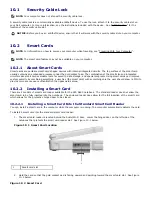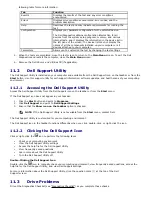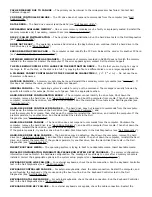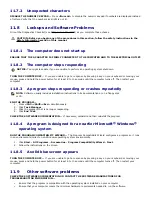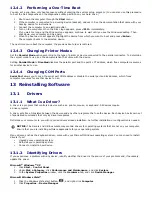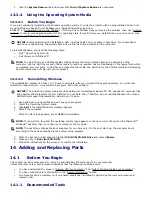
CACHE DISABLED DUE TO FAILURE — The primary cache internal to the microprocessor has failed. Contact Dell
Customer Support.
CD DRIVE CONTROLLER FAILURE — The CD drive does not respond to commands from the computer (see "
210H
Dell
Support Utility").
DATA ERROR — The hard drive cannot read the data (see "
211H
Dell Support Utility").
DECREASING AVAILABLE MEMORY — One or more memory modules may be faulty or improperly seated. Reinstall the
memory modules and, if necessary, replace them (see "
212H
Memory Problems").
DISK C: FAILED INITIALIZATION — The hard drive failed initialization. Run the hard drive tests in the Dell Diagnostics
(see "
213H
Dell Diagnostics").
DRIVE NOT READY — The operation requires a hard drive in the bay before it can continue. Install a hard drive in the
hard drive bay (see "
214H
Drive Problems”).
ERROR READING PCMCIA CARD — The computer cannot identify the PC Card. Reinsert the card or try another PC Card
(see "
215H
Installing a PC Card or ExpressCard").
EXTENDED MEMORY SIZE HAS CHANGED — The amount of memory recorded in NVRAM does not match the memory
installed in the computer. Restart the computer. If the error appears again, contact Dell Customer Support.
THE FILE BEING COPIED IS TOO LARGE FOR THE DESTINATION DRIVE — The file that you are trying to copy is
too large to fit on the disk, or the disk is too full. Try copying the file to a different disk or use a larger capacity disk.
A FILENAME CANNOT CONTAIN ANY OF THE FOLLOWING CHARACTERS: \ / : * ? “ < > | — Do not use these
characters in filenames.
GATE A20 FAILURE — A memory module may be loose. Reinstall the secondary memory modules (see "
216H
Memory"). If
this does not resolve the issue, contact Dell Customer Support.
GENERAL FAILURE — The operating system is unable to carry out the command. The message is usually followed by
specific information—for example, Printer out of paper. Take the appropriate action.
HARD-DISK DRIVE CONFIGURATION ERROR — The computer cannot identify the drive type. Shut down the
computer, remove the hard drive (see "
217H
Hard Drive Problems"), and boot the computer from media. Then shut down the
computer, reinstall the hard drive, and restart the computer. Run the Hard-Disk Drive tests in the Dell Diagnostics (see
"
218H
Dell Diagnostics").
HARD-DISK DRIVE CONTROLLER FAILURE 0 — The hard drive does not respond to commands from the computer.
Shut down the computer, remove the hard drive (see "
219H
Hard Drive Problems"), and
boot the computer from media. Then shut down the computer, reinstall the hard drive, and restart the computer. If the
problem persists, try another drive. Run the Hard-Disk Drive tests in the Dell
Diagnostics (see "
220H
Dell Diagnostics").
HARD-DISK DRIVE FAILURE — The hard drive does not respond to commands from the computer. Shutdown the
computer, remove the hard drive (see "
221H
Hard Drive Problems"), and boot the computer from media. Then shut down the
computer, reinstall the hard drive, and restart the computer.
If the problem persists, try another drive. Run the Hard-Disk Drive tests in the Dell Diagnostics (see "
222H
Dell Diagnostics").
HARD-DISK DRIVE READ FAILURE — The hard drive may be defective. Shut down the computer, remove the hard
drive (see "
223H
Hard Drive Problems"), and boot the computer from media. Then shut down the computer, reinstall the hard
drive, and restart the computer. If the problem persists, try another drive. Run the Hard-Disk Drive tests in the Dell
Diagnostics (see "
224H
Dell Diagnostics").
INSERT BOOTABLE MEDIA — The operating system is trying to boot to nonbootable media. Insert bootable media.
INVALID CONFIGURATION INFORMATION-PLEASE RUN SYSTEM SETUP PROGRAM — The system configuration
information does not match the hardware configuration. The message is most likely to occur after a memory module is
installed. Correct the appropriate options in the system setup program (see "
225H
System Setup Program").
KEYBOARD CLOCK LINE FAILURE — For external keyboards, check the cable connection. Run the Keyboard Controller
test in the Dell Diagnostics (see ""
226H
Dell Diagnostics").
KEYBOARD CONTROLLER FAILURE — For external keyboards, check the cable connection. Restart the computer, and
avoid touching the keyboard or the mouse during the boot routine. Run the Keyboard Controller test in the Dell
Diagnostics (see "
227H
Dell Diagnostics").
KEYBOARD DATA LINE FAILURE — For external keyboards, check the cable connection. Run the Keyboard Controller
test in the Dell Diagnostics (see "
228H
Dell Diagnostics").
KEYBOARD STUCK KEY FAILURE — For external keyboards or keypads, check the cable connection. Restart the



